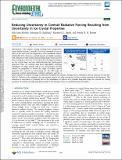Reducing Uncertainty in Contrail Radiative Forcing Resulting from Uncertainty in Ice Crystal Properties
Author(s)
Sanz-Morère, Inés; Eastham, Sebastian David; Speth, Raymond L; Barrett, Steven R. H.
Downloadacs.estlett.0c00150.pdf (1.267Mb)
Publisher with Creative Commons License
Publisher with Creative Commons License
Creative Commons Attribution
Terms of use
Metadata
Show full item recordAbstract
The radiative forcing resulting from condensation clouds behind aircraft (“contrails”) has been estimated to have an effect on the same order of magnitude as all accumulated aviation-attributable CO2. However, contrail impacts are highly uncertain, with estimates of total contrail-driven forcing made in the past five years varying by a factor of 4. Two of the key driving uncertainties are the crystal shape and size, which describe the cloud optical properties. Here we combine data from high-fidelity scattering simulations of single crystals with in situ measurement of bulk contrail ice properties to bound the range of realistic optical properties for contrail ice. Accounting for the full range of measured contrail microphysical evolution pathways, and for a given estimate of contrail coverage, we find that the global net radiative forcing due to contrails in 2015 is between 8.6 and 10.7 mW/m². Relative to the midpoint, this uncertainty range is less than one-quarter of that recently reported in the literature. This reduction in uncertainty is primarily due to the elimination of spheres as a plausible long-term shape for contrail ice, leaving questions of contrail coverage and optical depth as the primary causes of contrail forcing uncertainty.
Date issued
2020-03Department
Massachusetts Institute of Technology. Laboratory for Aviation and the Environment; Massachusetts Institute of Technology. Department of Aeronautics and AstronauticsJournal
Environmental Science and Technology Letters
Publisher
American Chemical Society (ACS)
Citation
Sanz-Morère, Inés et al. "Reducing Uncertainty in Contrail Radiative Forcing Resulting from Uncertainty in Ice Crystal Properties." Environmental Science and Technology Letters 7, 6 (March 2020): 371–375 © 2020 American Chemical Society
Version: Final published version
ISSN
2328-8930
2328-8930